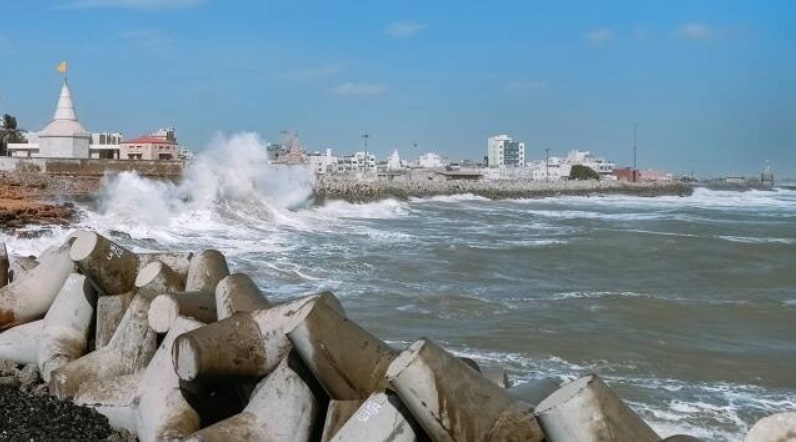What’s in today’s article?
- Why in news?
- What are Cyclones?
- Naming of Cyclones
- News Summary: Cyclonic storm ‘Biparjoy’ likely to hit Gujarat
- Development of cyclones in the Arabian sea
- Cyclones developed in Arabian Sea and Indian Coast
Why in news?
- The extremely severe cyclonic storm Biparjoy expected to make landfall on Gujarat’s Kutch coast on June 15.
- There is yet no clarity about the exact location of its landing.
- However, the India Meteorological Department (IMD) said that Biparjoy is very likely to make landfall at some point between Mandvi in Gujarat and Karachi in Pakistan, with a maximum sustained wind speed of 125 to 135 kmph, gusting to 150 kmph.
What are Cyclones?
- Formation of cyclones
- Tropical Cyclone is a weather phenomenon, which is formed only over warm ocean waters near the equator.
- Warm, moist air rises up and away from the ocean surface, creating an area of low pressure.
- It causes the air from surrounding areas with higher pressure to move towards the low-pressure area.
- This leads to warming up of air and causes it to rise above.
- As the air rises & cools, the water in the air forms clouds.
- This complete system of clouds and wind spins & grows, along with the ocean’s heat.
- As the wind rotation speed increases, an eye gets formed in the middle.
- Characteristics of a Tropical Cyclone:
- The centre of a cyclone is very calm and clear with very low air pressure. The average speed is 120 kmph.
- They have closed isobars which leads to greater velocity.
- Isobars are imaginary lines on a weather map that connect locations with equal atmospheric pressure.
- They develop over oceans and sea only.
- They move from east to west under the influence of trade winds.
- They are seasonal in nature.
- Classification of cyclones
- Cyclones are classified on the basis of wind speed by the Indian Meteorological Department (IMD):
- Depression: Wind speeds of between 31–49 km/h
- Deep Depression: Between 50-61 km/h
- Cyclonic Storm: Between 62–88 km/h
- Severe Cyclonic Storm: Between 89-117 Km/h
- Very Severe Cyclonic Storm: Between 118-166 Km/h
- Extremely Severe Cyclonic Storm: Between 166-221 Km/h
- Super Cyclonic Storm: Above 222 Km/h
Naming of Cyclones
- ‘Biparjoy’ was suggested by Bangladesh. The naming of cyclones is done by countries on a rotational basis, following certain existing guidelines.
- Worldwide, there are six regional specialised meteorological centres (RSMCs) and five regional Tropical Cyclone Warning Centres (TCWCs) mandated for issuing advisories and naming of tropical cyclones.
- The five regional Tropical Cyclone Warning Centres (TCWCs) are:
- ESCAP/WMO Typhoon Committee,
- WMO/ESCAP Panel on Tropical Cyclones,
- It is responsible for naming of cyclones in the Indian Ocean.
- RA I Tropical Cyclone Committee,
- RA IV Hurricane Committee,
- RA V Tropical Cyclone Committee.
- IMD is one of the six RSMCs to provide tropical cyclone and storm surge advisories to under the WMO/Economic and Social Commission for Asia-Pacific (ESCAP).
- WMO/ ESCAP is an inter-governmental regional body jointly established by the World Meteorological Organization (WMO) and the United Nations Economic and Social Commission for Asia-Pacific (ESCAP) in 1972.
- Members – It has 13 countries as its members.
- Bangladesh, India, Iran, Maldives, Myanmar, Oman, Pakistan, Qatar, Saudi Arabia, Sri Lanka, Thailand, United Arab Emirates and Yemen.
- They contribute to a set of names which are assigned sequentially whenever a cyclonic storm develops.
- The list of 169 cyclone names released by IMD in 2020 was provided by these countries — 13 suggestions from each of the 13 countries.
- So, the tropical cyclones forming over different Ocean basins are named by the concerned RSMCs & TCWCs.
News Summary: Cyclonic storm ‘Biparjoy’ likely to hit Gujarat
- The cyclone Biparjoy in the Arabian Sea, earlier seemed headed towards the Pakistan coastline, is now predicted to move slightly east towards the northern Gujarat coast.
Development of cyclones in the Arabian sea
- There are fewer number of cyclones in the Arabian Sea than the Bay of Bengal, but it is not uncommon.
- In fact, June is one of the favourable months for the formation of cyclones in the Arabian Sea.
- Bay of Bengal is slightly warmer. Hence, we see greater number of cyclones in the Bay of Bengal compared to Arabian Sea.
- However, due to climate change, the Arabian Sea side is also getting warmer, and as a result, the number of cyclones in the Arabian Sea is showing an increasing trend in the recent trend.
Cyclones developed in Arabian Sea and Indian Coast
- Cyclones in the Arabian Sea usually do not move towards the Indian coast.
- Most of them, more than 75 per cent of all Arabian Sea cyclones, move northwards or northwestwards.
- Some of them dissipate their energy over the sea itself.
- Only a small number of them, less than 25 per cent, move northeast, mainly towards the Gujarat coast.
Q1) What is Economic and Social Commission for Asia-Pacific (ESCAP)?
The Economic and Social Commission for Asia and the Pacific (ESCAP) is a regional commission of the United Nations (UN) that serves as the largest intergovernmental platform for promoting economic and social development in the Asia-Pacific region. It was established in 1947 and is headquartered in Bangkok, Thailand. ESCAP’s primary goal is to support member countries in achieving sustainable and inclusive development by providing policy advice, technical assistance, and capacity-building initiatives. The commission facilitates regional cooperation and coordination among its member countries to address common development challenges and promote regional integration.
Q2) What is India Meteorological Department (IMD)?
The India Meteorological Department (IMD) is the national meteorological service of India. It is responsible for meteorological observations, weather forecasting, and monitoring of weather-related phenomena in the country. The IMD is under the Ministry of Earth Sciences of the Government of India.
Source: Alert sounded as cyclone Biparjoy changes its path, heads to Gujarat coast | The Hindu | Indian Express
Last updated on June, 2025
→ UPSC Notification 2025 was released on 22nd January 2025.
→ UPSC Prelims Result 2025 is out now for the CSE held on 25 May 2025.
→ UPSC Prelims Question Paper 2025 and Unofficial Prelims Answer Key 2025 are available now.
→ UPSC Calendar 2026 is released on 15th May, 2025.
→ The UPSC Vacancy 2025 were released 1129, out of which 979 were for UPSC CSE and remaining 150 are for UPSC IFoS.
→ UPSC Mains 2025 will be conducted on 22nd August 2025.
→ UPSC Prelims 2026 will be conducted on 24th May, 2026 & UPSC Mains 2026 will be conducted on 21st August 2026.
→ The UPSC Selection Process is of 3 stages-Prelims, Mains and Interview.
→ UPSC Result 2024 is released with latest UPSC Marksheet 2024. Check Now!
→ UPSC Toppers List 2024 is released now. Shakti Dubey is UPSC AIR 1 2024 Topper.
→ Also check Best IAS Coaching in Delhi






















